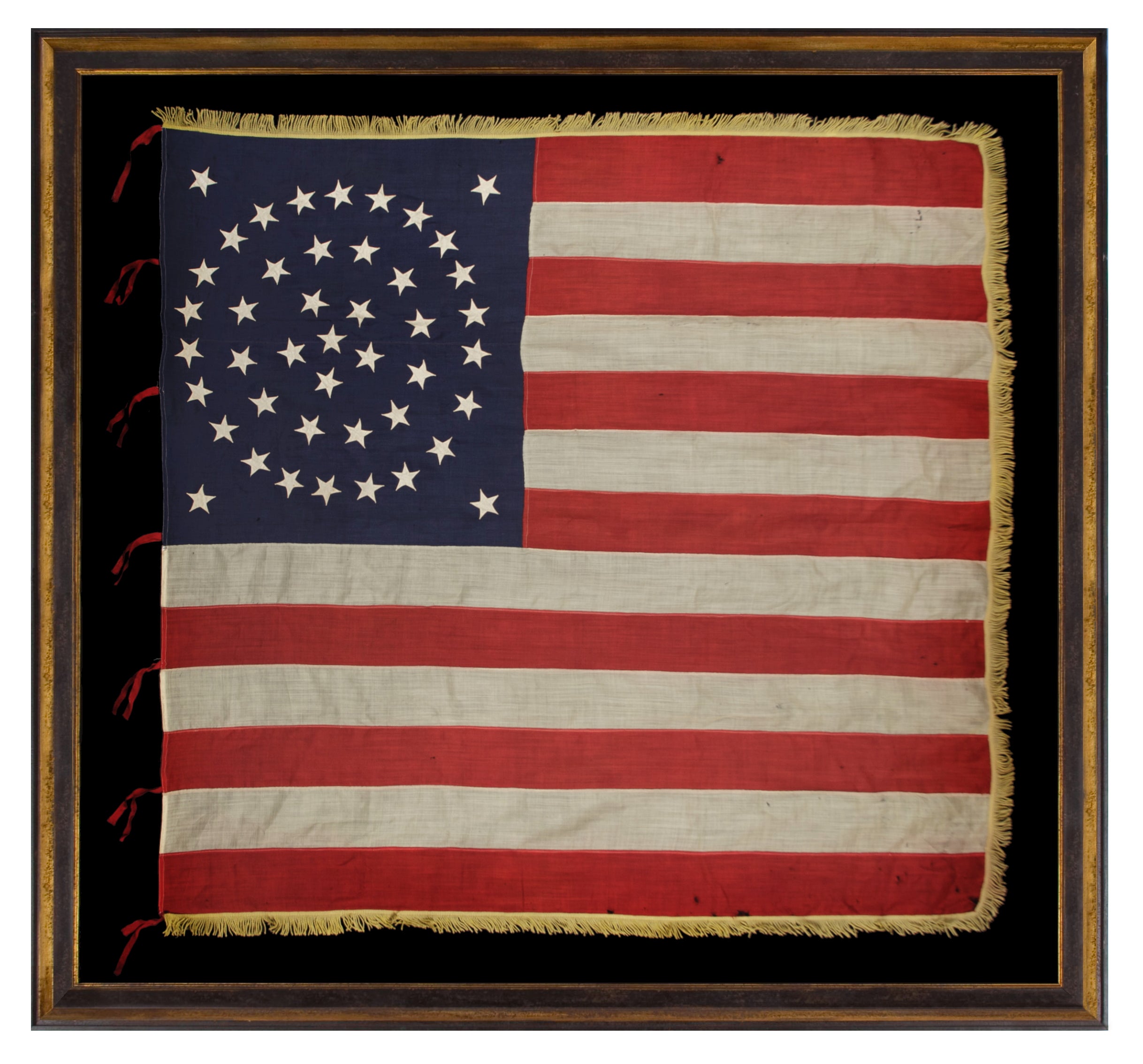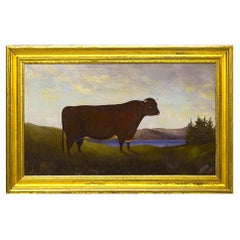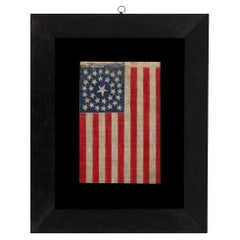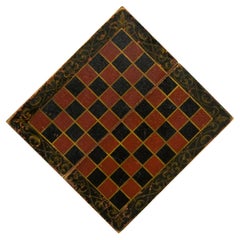About Jeff R. Bridgman American Antiques
As an advisor to top museums and collectors alike, Jeff Bridgman is the world's leading expert and source for antique American flags and political textiles. In this field there are many fakes, forgeries, and misrepresented items, and there is no substitute for experience. As the nation's leading buyer and seller, Jeff R. Bridgman Antiques, Inc. has handled more material than anyone in the field. Jeff has also operated a textile conservation business for 18 years, where expert staff have conservation mounted, framed and restored thousands of examples, more than anyone ...Read More

Established in 19911stDibs seller since 2008
Featured Pieces
American Folk Painting of a Bull, ca 1885
Located in York County, PA
Folk portrait of a bull in oil on canvas, signed L.D.D. and dated 1885. Found at an estate in the Hudson, New York area. The painting’s great style and presence in the stylized anima...
Category
Antique 1850s American Paintings
Materials
Canvas
Early 20th Century British Union Flag, ca 1918-1952
Located in York County, PA
BRITISH UNION FLAG OF THE EARLY 20TH CENTURY, WITH BRILLIANT AND UNUSUAL, COBALT BLUE COLORATION, AND A SIMPLIFIED, FOLK STYLE, WITH INCORRECT PROPORTIONS IN THE CROSSES OF ST. ANDRE...
Category
Mid-20th Century English Political and Patriotic Memorabilia
Materials
Wool
33 star Antique American Parade Flag with Stars in a Double Wreath Configuration
Located in York County, PA
33 STARS IN A DOUBLE-WREATH CONFIGURATION, ON AN ANTIQUE AMERICAN FLAG DATING IMMEDIATELY PRE-CIVIL WAR THROUGH THE WAR'S OPENING YEAR, REFLECTS THE ADDITION OF OREGON TO THE UNION, ...
Category
Mid-20th Century American Political and Patriotic Memorabilia
Materials
Cotton
Antiques American Checker or Chess Game Board, ca 1840-1870
Located in York County, PA
ANTIQUE AMERICAN GAME BOARD, CHECKERS OR CHESS, RED & BLACK w/ SHADOWED GOLD SCROLLWORK, circa 1840-70
This diminutive, folding, checkers & chess game board was found in New England...
Category
20th Century American Game Boards
Materials
Wood
Red & White Sunshine and Shadows Signature Quilt, Ca 1901
Located in York County, PA
RED & WHITE, SUNSHINE & SHADOWS, SIGNATURE QUILT, MADE BY THE LADIES AID SOCIETY CHAPTER AT THE UNITED EVANGELICAL CHURCH IN ROYERSFORD, PENNSYLVANIA, MONTGOMERY COUNTY, DATED 1901
...
Category
Early 20th Century American Quilts
Materials
Cotton
Vintage Republic of Texas Flag, Made by Decorators, Inc, ca 1930-1950
Located in York County, PA
VINTAGE FLAG OF THE REPUBLIC OF TEXAS, THAT BECAME THE TEXAS STATE FLAG, MADE BY DECORATORS, INC. OF BRAZIL, INDIANA, [LATER KNOWN AS THE “OLD GLORY DECORATING COMPANY”], MOST LIKELY...
Category
Mid-20th Century American Political and Patriotic Memorabilia
Materials
Cotton
48 Star, US Navy Small Boat Ensign, Made at Mare Island, CA ca 1944
Located in York County, PA
48 STAR, U.S. NAVY SMALL BOAT ENSIGN, MADE AT MARE ISLAND, CALIFORNIA DURING WWII, SIGNED AND DATED 1944, IN THE SMALLEST SCALE EMPLOYED AT THE TIME
48 star American national flag, ...
Category
Vintage 1940s American Political and Patriotic Memorabilia
Materials
Wool
Vintage California State "Bear" Flag, ca 1940-1960
Located in York County, PA
VINTAGE CALIFORNIA STATE "BEAR" FLAG OF STOUT CONSTRUCTION, AND WITH SIGNIFICANT GOLDEN BROWN OXIDATION THAT LENDS TO BEAUTIFUL PATINA AND CONVEYS ITS AGE; LATTER 1940’s - 1960’s
Early state flags fall between very scarce and extraordinarily rare in the antiques marketplace. One primary reason for this is that most states, even if they existed during the 18th or 19th century, didn’t actually adopt flags until the early 20th century. The Maryland State Legislature, for example, didn’t find need for a state banner until 1904, in spite of the fact that Maryland was one of the original 13 colonies. Other states had crests or symbols that were tied to the state legislature in some way, or to local patriotism, but didn't accept an official design until many years following statehood.
In the case of California, the "Bear Flag," as all California state flags and variations thereof are often called, is based on a significant early example. The eldest surviving Bear Flag is thought to date to the 1846 “Bear Flag Revolt”. This occurred when Major John Frémont arrived in the state on a so-called mission to reach the Pacific and encouraged an uprising against Mexican rule in the territory. Frémont claimed himself military governor of the California Republic and was brought up on charges of treason for his actions, but was pardoned by President James Polk. Polk was an expansionist and Frémont’s actions brought California to statehood in 1850, immediately following the 1849 Gold Rush.
The original Bear Flag was designed and made by William L. Todd, a first cousin to Abraham Lincoln’s wife, Mary Todd. Painted on cotton, it had a white field with a red stripe along the bottom, just like the modern design. The star image was taken from what was known as the “California Lone Star Flag”, flown during California's previous, 1836 revolt. Like the modern California flag, the red star appeared the upper hoist-end corner, but the bear was placed next to the star. On a later version, designed by a man named Peter Storm...
Category
Mid-20th Century American Political and Patriotic Memorabilia
Materials
Cotton
42 Stars on a Antique American Parade Flag, Washington Statehood, ca 1889-1890
Located in York County, PA
42 STARS ON AN ANTIQUE AMERICAN FLAG WITH A WAVE CONFIGURATION OF LINEAL COLUMNS, AN UNOFFICIAL STAR COUNT THAT REFLECTS THE ADDITION OF WASHINGTON STATE, MONTANA, AND THE DAKOTAS, c...
Category
Antique Late 19th Century American Political and Patriotic Memorabilia
Materials
Cotton
Exceptional American Flag, 38 Stars in 3 Sizes in a Fantastic, Unusual Medallion
Located in York County, PA
EXCEPTIONAL ANTIQUE AMERICAN FLAG WITH 38 GLAZED COTTON STARS, IN 3 DIFFERENT SIZES, ARRANGED IN A BEAUTIFULLY GRAPHIC, DOUBLE-WREATH STYLE MEDALLION, WITH TRIANGLES OF 4 STARS IN ...
Category
Antique Late 19th Century North American Political and Patriotic Memorab...
Materials
Silk
13 Star Antique American Parade Flag, ca 1876-1899
Located in York County, PA
13 STAR ANTIQUE AMERICAN PARADE FLAG, WITH A 3-2-3-2-3 CONFIGURATION OF STARS, AN EXTREMELY SCARCE AND UNUSUALLY LARGE VARIETY, MADE circa 1876-1899
13 star American national parade...
Category
Antique Late 19th Century Canadian Political and Patriotic Memorabilia
Materials
Cotton
Suffrage Textile in Green, White, & Violet - Votes for Women - Connecticut Made
Located in York County, PA
VOTES FOR WOMEN PARADE TEXTILE IN GREEN, WHITE, & VIOLET, OF A TYPE WORN AS SASHES AND WAVED AS NARROW PARADE BANNERS, MADE IN HARTFORD, CONNECTICUT BY CALHOUN PRESS FOR THE WOMEN'S ...
Category
Early 20th Century American Political and Patriotic Memorabilia
Materials
Cotton
More About Jeff R. Bridgman American Antiques








